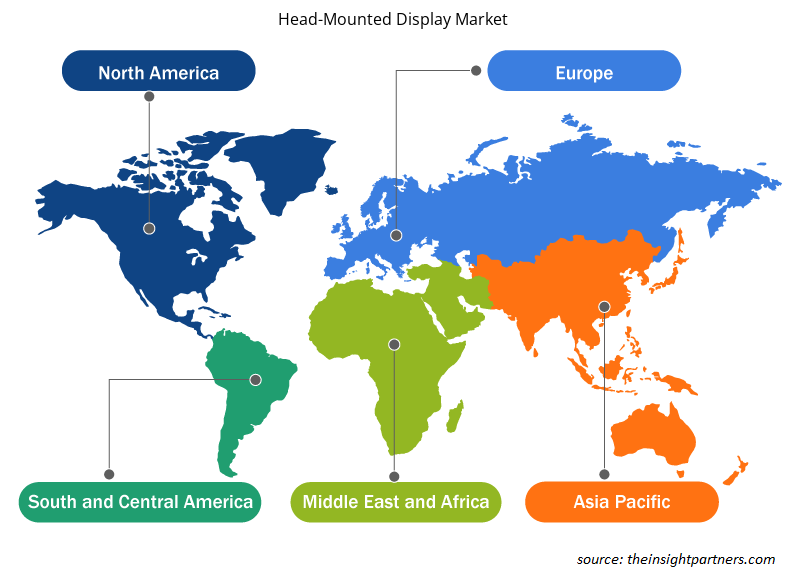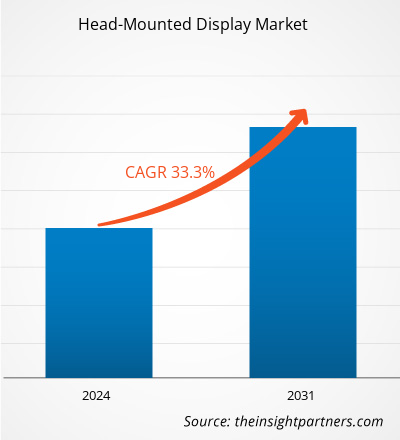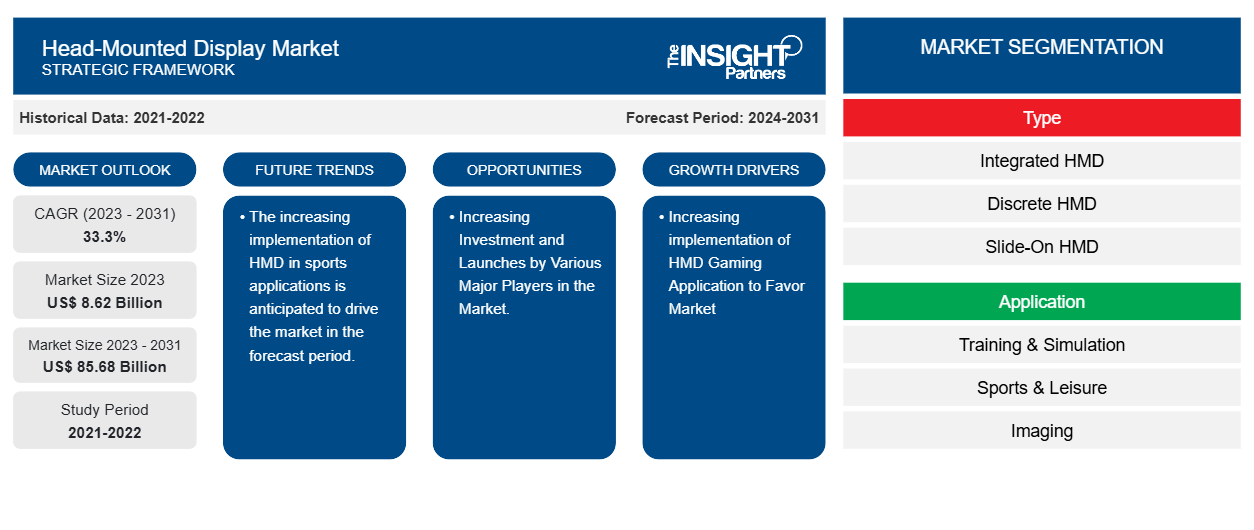Le marché des visiocasques devrait atteindre 85,68 milliards de dollars d'ici 2031, contre 8,62 milliards de dollars en 2023. Le marché devrait enregistrer un TCAC de 33,3 % au cours de la période 2023-2031. L'implémentation de HMD dans les applications de jeu et l'adoption croissante des casques AR/VR dans le secteur militaire devraient être les principaux moteurs et tendances du marché.
Analyse du marché des visiocasques
Le marché des visiocasques connaît une croissance significative à l'échelle mondiale. Cette croissance est attribuée à des facteurs tels que la mise en œuvre de visiocasques dans les applications de jeu et l'adoption croissante des casques AR/VR dans le secteur militaire. De plus, l'investissement croissant des principaux acteurs dans le développement de visiocasques et la mise en œuvre de visiocasques dans les applications sportives devraient offrir plusieurs opportunités au marché dans les années à venir.
Aperçu du marché des visiocasques
Un visiocasque (HMD) est un type de dispositif d'affichage ou de moniteur informatique qui, comme son nom l'indique, est porté sur la tête ou intégré dans un casque. Ce type d'écran est destiné à une immersion totale de l'utilisateur dans l'expérience à laquelle il est destiné, car il garantit que l'écran se déplace avec les mouvements de l'utilisateur.
Personnalisez ce rapport en fonction de vos besoins
Vous bénéficierez d'une personnalisation gratuite de n'importe quel rapport, y compris de certaines parties de ce rapport, d'une analyse au niveau des pays, d'un pack de données Excel, ainsi que de superbes offres et réductions pour les start-ups et les universités.
-
Obtenez les principales tendances clés du marché de ce rapport.Cet échantillon GRATUIT comprendra une analyse de données, allant des tendances du marché aux estimations et prévisions.
Moteurs et opportunités du marché des visiocasques
Mise en œuvre croissante de l'application HMD Gaming pour favoriser le marché
L'AR/VR/MR est expérimentée grâce à l'utilisation d'appareils spéciaux appelés HMD. La plupart des HMD sont basés sur la technique d'affichage 3D stéréoscopique. Elle exploite un signal de profondeur appelé stéréopsie, qui n'est rien d'autre que la profondeur que les yeux humains perçoivent parce que chacun de nos deux yeux voit une scène sous un angle légèrement différent. Les applications de jeu exploitant les HMD offrent une expérience hautement immersive en créant un environnement virtuel qui entoure le joueur. Ce niveau d'immersion est un argument de vente majeur et peut attirer les joueurs occasionnels comme les joueurs chevronnés. De plus, les améliorations continues de la technologie HMD, telles qu'une meilleure résolution, un champ de vision plus large, une latence réduite et un suivi amélioré, rendent les expériences de jeu plus réalistes et plus agréables, encourageant davantage d'utilisateurs à adopter ces appareils.
Augmentation des investissements et des lancements par divers acteurs majeurs du marché.
Le nombre croissant de lancements de produits par les principaux acteurs du marché devrait offrir plusieurs opportunités pour le marché. Les lancements de nouveaux produits s'accompagnent souvent de fonctionnalités avancées, d'une technologie améliorée et de meilleures performances. Divers lancements de produits, tels que Sony et Siemens, ont annoncé qu'ils lanceraient des casques de réalité virtuelle pour le métavers industriel de ce dernier d'ici décembre 2024. Le produit est actuellement intégré à la plateforme de conception technique NX de Siemens et sera étendu à d'autres produits. Ainsi, un nombre croissant d'investissements et de lancements par divers acteurs majeurs devrait stimuler la croissance du marché.
Analyse de segmentation du rapport sur le marché des visiocasques
Les segments clés qui ont contribué à l’élaboration de l’analyse du marché des visiocasques sont le type, l’application, le composant, la technologie, la conception et la connexion.
- En fonction du type, le marché des visiocasques est divisé en HMD intégrés, HMD discrets et HMD coulissants. Le segment HMD intégré devrait détenir une part de marché importante au cours de la période de prévision.
- En fonction des applications, le marché des visiocasques est divisé en formation et simulation, sports et loisirs, imagerie, défense et sécurité, etc. Le segment du durcissement des radiations par conception (RHBD) devrait détenir une part de marché importante au cours de la période de prévision.
- Par composant, le marché est segmenté en écrans d'affichage, contrôleurs, capteurs, caméras et autres. Le segment des écrans d'affichage devrait détenir une part de marché importante au cours de la période de prévision.
- En termes de technologie, le marché est segmenté en réalité augmentée, réalité virtuelle et réalité mixte. Le segment des écrans d'affichage devrait détenir une part de marché importante au cours de la période de prévision.
- De par sa conception, le marché est segmenté en visiocasques et en lunettes portables. Le segment des écrans d'affichage devrait détenir une part de marché importante au cours de la période de prévision.
- En termes de connexion, le marché est segmenté en filaire, sans fil et hybride. Le segment filaire devrait détenir une part de marché importante au cours de la période de prévision.
Analyse des parts de marché des visiocasques par zone géographique
La portée géographique du rapport sur le marché des écrans montés sur la tête est principalement divisée en cinq régions : Amérique du Nord, Asie-Pacifique, Europe, Moyen-Orient et Afrique, et Amérique du Sud et centrale.
L'Amérique du Nord domine le marché des visiocasques. Les tendances d'adoption de haute technologie dans diverses industries de la région nord-américaine ont alimenté la croissance du marché des visiocasques. Des facteurs tels que l'adoption accrue d'outils numériques et les dépenses technologiques élevées des agences gouvernementales devraient stimuler la croissance du marché nord-américain des visiocasques. De plus, l'accent mis sur la recherche et le développement dans les économies développées des États-Unis et du Canada oblige les acteurs nord-américains à introduire des solutions technologiquement avancées sur le marché. En outre, les États-Unis comptent de nombreux acteurs du marché des visiocasques qui se concentrent de plus en plus sur le développement de solutions innovantes. Tous ces facteurs contribuent à la croissance du marché des visiocasques dans la région.
Aperçu régional du marché des visiocasques
Les tendances et facteurs régionaux influençant le marché des visiocasques tout au long de la période de prévision ont été expliqués en détail par les analystes d’Insight Partners. Cette section traite également des segments et de la géographie du marché des visiocasques en Amérique du Nord, en Europe, en Asie-Pacifique, au Moyen-Orient et en Afrique, ainsi qu’en Amérique du Sud et en Amérique centrale.

- Obtenez les données régionales spécifiques au marché des visiocasques
Portée du rapport sur le marché des visiocasques
| Attribut de rapport | Détails |
|---|---|
| Taille du marché en 2023 | 8,62 milliards de dollars américains |
| Taille du marché d'ici 2031 | 85,68 milliards de dollars américains |
| Taux de croissance annuel composé mondial (2023-2031) | 33,3% |
| Données historiques | 2021-2022 |
| Période de prévision | 2024-2031 |
| Segments couverts |
Par type
|
| Régions et pays couverts |
Amérique du Nord
|
| Leaders du marché et profils d'entreprises clés |
|
Densité des acteurs du marché : comprendre son impact sur la dynamique des entreprises
Le marché des visiocasques connaît une croissance rapide, tirée par la demande croissante des utilisateurs finaux en raison de facteurs tels que l'évolution des préférences des consommateurs, les avancées technologiques et une plus grande sensibilisation aux avantages du produit. À mesure que la demande augmente, les entreprises élargissent leurs offres, innovent pour répondre aux besoins des consommateurs et capitalisent sur les tendances émergentes, ce qui alimente davantage la croissance du marché.
La densité des acteurs du marché fait référence à la répartition des entreprises ou des sociétés opérant sur un marché ou un secteur particulier. Elle indique le nombre de concurrents (acteurs du marché) présents sur un marché donné par rapport à sa taille ou à sa valeur marchande totale.
Les principales entreprises opérant sur le marché des visiocasques sont :
- Microsoft
- Sony
- Oculus VR
- Lenovo
- Saut magique Inc.
- Systèmes BAE
Avis de non-responsabilité : les sociétés répertoriées ci-dessus ne sont pas classées dans un ordre particulier.

- Obtenez un aperçu des principaux acteurs du marché des visiocasques
Actualités et développements récents du marché des visiocasques
Le marché des visiocasques est évalué en collectant des données qualitatives et quantitatives après des recherches primaires et secondaires, qui comprennent d'importantes publications d'entreprise, des données d'association et des bases de données. Quelques-uns des développements du marché des visiocasques sont répertoriés ci-dessous :
- Sony et Siemens lanceront d'ici décembre 2024 un casque de réalité virtuelle destiné au métavers industriel de cette dernière. Le produit est actuellement intégré à la plateforme de conception technique NX de Siemens et sera étendu à d'autres produits. (Source : site Web de Sony, mai 2024)
- Sony Corporation a annoncé le développement d'un système de création de contenu spatial équipé d'un casque d'affichage XR de haute qualité et de contrôleurs dédiés à l'interaction avec des objets 3D. (Source : site Web de Sony Corporation, janvier 2024)
Rapport sur le marché des visiocasques et livrables
Le rapport « Taille et prévisions du marché des visiocasques (2021-2031) » fournit une analyse détaillée du marché couvrant les domaines ci-dessous :
- Taille et prévisions du marché des visiocasques aux niveaux mondial, régional et national pour tous les segments de marché clés couverts dans le cadre.
- Tendances du marché des visiocasques ainsi que dynamique du marché telles que les moteurs, les contraintes et les opportunités clés.
- Analyse détaillée des cinq forces de PEST/Porter et SWOT.
- Analyse du marché des visiocasques couvrant les principales tendances du marché, le cadre mondial et régional, les principaux acteurs, les réglementations et les développements récents du marché.
- Analyse du paysage industriel et de la concurrence couvrant la concentration du marché, l'analyse de la carte thermique, les principaux acteurs et les développements récents pour le marché des visiocasques
- Profils d'entreprise détaillés.
- Analyse historique (2 ans), année de base, prévision (7 ans) avec TCAC
- Analyse PEST et SWOT
- Taille du marché Valeur / Volume - Mondial, Régional, Pays
- Industrie et paysage concurrentiel
- Ensemble de données Excel
Rapports récents
Rapports connexes
Témoignages
Raison d'acheter
- Prise de décision éclairée
- Compréhension de la dynamique du marché
- Analyse concurrentielle
- Connaissances clients
- Prévisions de marché
- Atténuation des risques
- Planification stratégique
- Justification des investissements
- Identification des marchés émergents
- Amélioration des stratégies marketing
- Amélioration de l'efficacité opérationnelle
- Alignement sur les tendances réglementaires























 Obtenez un échantillon gratuit pour - Marché des visiocasques
Obtenez un échantillon gratuit pour - Marché des visiocasques